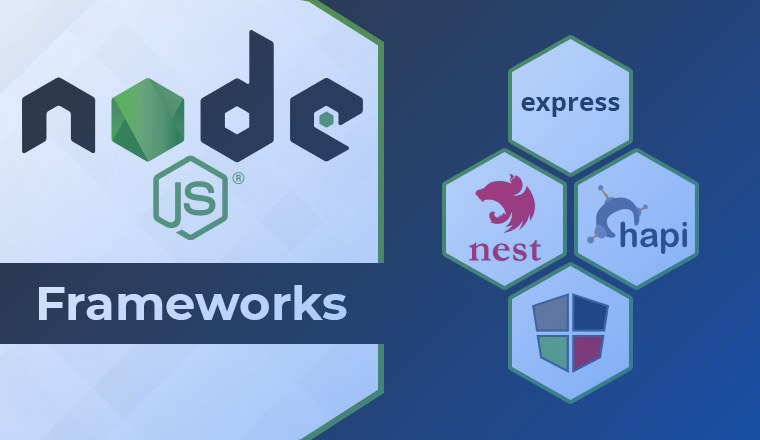In the rapidly evolving landscape of web development, Node.js has emerged as a formidable player, and with it, a suite of powerful web frameworks that facilitate building robust applications its also used in react and react native. In this comprehensive guide, we’ll dive deep into the world of Node.js web frameworks, putting a spotlight on top 5 node.js frameworks like Express.js, Koa, Socket.io, Hapi.js, and NestJS. By the end of this journey, you’ll have a clear understanding of their unique offerings, strengths, and use cases, empowering you to make informed decisions when selecting the perfect framework for your next project.
Node.js and Web Frameworks: Clarifying the Difference
Node.js is often confused with a web framework, but it’s actually a runtime environment for executing JavaScript on a server. Unlike frameworks, which provide the structural foundation for applications, Node.js is the platform facilitating code execution. A framework to a skeletal structure tailored to a specific environment. Consequently, utilizing Node.js requires pairing it with a web framework, often referred to as a node web framework.
Understanding MVC and REST API Architectural Styles
Two major approaches to backend development are the Model-View-Controller (MVC) architecture and Representational State Transfer (REST) API. These styles are not mutually exclusive and can be employed concurrently.
Model-View-Controller (MVC)
MVC divides an application into three components:
- Model: Manages application data, interacts with databases, and handles data logic.
- View: Renders data presentation passed by the model.
- Controller: Regulates data flow, processes user input, and interacts with the model.
Frameworks like Koa, Django, Express, and NestJS lend themselves well to developing the backend with an MVC pattern. This separation of concerns streamlines development by organizing data, presentation, and data manipulation modules.
REST API
REST APIs facilitate communication between multiple web services. They adhere to specific constraints:
- Client and server code independence.
- Statelessness, where neither side needs knowledge of the other’s state.
- Operations on resources communicated via HTTP methods (e.g., GET, POST).
- No reliance on a particular API implementation.
REST APIs foster efficient communication by responding to client requests with representations of resource states. These representations often employ JSON payloads, but HTML, XML, Python, PHP, or plain text can also be used.
Top 5 Best Node.js Frameworks: Features and Use Cases

Several noteworthy Node web frameworks used to different application requirements. Now that we’ve got the theory down, let’s delve into some notable best 5 Node.js frameworks and where they excel:
1. Express.js: (A Backbone for Web Applications)
The popular all-rounder. It’s versatile, great for routing, and embraces the MVC architecture. Plus, it supports concurrent handling of multiple independent operation requests, ensuring top-notch performance.
Features of Express,js:
- Popular and versatile framework.
- Facilitates routing and middleware.
- Offers straightforward JavaScript coding with a manageable learning curve.
- Supports MVC architecture.
- Provides debugging mechanisms for error identification.
- Ensures high performance by handling multiple independent operation requests concurrently.
For whom express.js is suitable for:
It excels in facilitating routing and middleware, making it easy to handle different routes and manage middleware functions. In my opinion Express.js is suitable for every person who started using node.js as it hides complexity and make code easy to understand.
2. Koa: (Empowering Expressiveness)
Born from the minds behind Express.js, Koa focuses on robust yet expressive applications. Its use of async functions eliminates callback headaches, making it a hit for complex projects in experienced hands.
Features of Koa:
- Designed by the creators of Express.js.
- Focuses on smaller, more expressive, and robust applications.
- Utilizes async functions to eliminate the need for callbacks.
- Suited for high-performance, complex applications developed by experienced teams.
For whom Koa is suitable for ?
Koa leverages asynchronous functions to eliminate the need for callbacks, resulting in cleaner and more readable code. It is particularly suited for high-performance and complex applications that are developed by experienced teams.
3. Socket.io: (Real-Time Communication)
The go-to for real-time data exchange. Socket.io is well-suited for applications that require real-time updates, such as chat rooms, text apps, video conferencing, and multiplayer games. It can push data from servers to clients without requiring the client to actively request the data, making it suitable for scenarios where instant data updates are crucial.
Featues of Socket.io:
- Ideal for real-time bidirectional data exchange.
- Enables WebSocket-based communication.
- Pushes data from servers to clients without client invocation.
For whom Socket.io is best suitable for ?
Suitable for chat rooms, text apps, video conferencing, and multiplayer games.
4. Hapi.js (Security and Extensibility at the Core)
Security-first and open-source. With a buffet of built-in plugins, you’ll find yourself relying less on unofficial middleware. Its forte lies in creating proxies, API servers, REST APIs, and even desktop applications.
Features of Hapi,js:
- Secure open-source framework with built-in security features.
- Abundant built-in plugins, minimizing the need for unofficial middleware.
- Known for developing proxy, API servers, REST APIs, and desktop applications.
For whom Hapi.js is best suitable for ?
Hapi.js is often chosen for developing proxy servers, API servers, REST APIs, and even desktop applications. It’s the ideal framework for projects demanding robust security measures, making it a favorite for creating proxy servers
5. NestJS:
The dynamic player for scalable enterprise applications. Built on Express.js and embracing TypeScript compatibility, NestJS plays exceptionally well with the Angular front-end framework. It’s a fusion of object-oriented and functional reactive programming paradigms.
Features of NestJS:
- Follows MVC architecture.
- Built on top of Express.js.
- TypeScript compatibility.
- Works seamlessly with the Angular front-end framework.
- Combines object-oriented and functional reactive programming.
What NestJS is best suitable for ?
NestJS is built on top of Express.js and offers TypeScript compatibility, making it a strong choice for projects that value strong typing and maintainability. It seamlessly integrates with the Angular front-end framework and combines object-oriented and functional reactive programming paradigms, providing a versatile foundation for building complex applications.
In Conclusion:
In a world where web development requires precision and efficiency, choosing the right framework is crucial. We explain the top 5 Node.js frameworks Express.js, Koa, Socket.io, Hapi.js, and NestJS each bring unique strengths to the table. From facilitating routing to real-time communication, security-first design to enterprise scalability, these frameworks offer solutions for various project requirements. So, whether you’re building a modern web app or a complex enterprise solution, there’s a Node.js framework tailored to your needs.
FAQs
Q1: Is Express.js suitable for beginners in web development?
A1: Yes, Express.js features an approachable learning curve, making it suitable for beginners to grasp the basics of web development.
Q2: Can Socket.io be used for applications other than real-time chat?
A2: Absolutely, Socket.io’s real-time capabilities extend to various applications, including multiplayer games and live updates in collaborative tools.
Q3: What type of projects are best suited for Hapi.js?
A3: Hapi.js is well-suited for projects that prioritize security, such as API servers, REST APIs, and applications where data protection is critical.
Q4: Does NestJS only work with Angular?
A4: While NestJS integrates seamlessly with Angular, it can be used independently to develop dynamic and scalable enterprise applications.


Pingback: Quiz / MCQ's Related To Node.js - AlliKnows
Pingback: How to Build Node.js http-proxy-middleware with Express ?